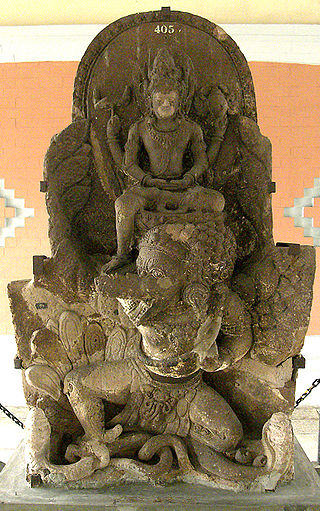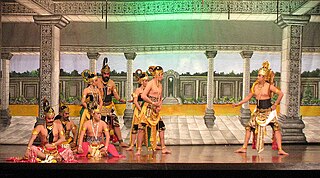
Gamelan is the traditional ensemble music of the Javanese, Sundanese, and Balinese peoples of Indonesia, made up predominantly of percussive instruments. The most common instruments used are metallophones played by mallets and a set of hand-played drums called kendhang/Kendang, which register the beat. The kemanak and gangsa are commonly used gamelan instruments in Bali. Other instruments include xylophones, bamboo flutes, a bowed instrument called a rebab, a zither-like instrument siter and vocalists named sindhen (female) or gerong (male).

The kris, or keris in the Indonesian languages, is an Indonesian asymmetrical dagger with distinctive blade-patterning achieved through alternating laminations of iron and nickelous iron (pamor). Of Javanese origin, the kris is famous for its distinctive wavy blade, although many have straight blades as well, and is one of the weapons commonly used in the pencak silat martial art, native to Indonesia.
Barong may refer to any of the following things:

Rangda is the demon queen of the Leyaks in Bali, according to traditional Balinese mythology. Terrifying to behold, the child-eating Rangda leads an army of evil witches against the leader of the forces of good — Barong. The battle between Barong and Rangda is featured in a Barong dance which represents the eternal battle between good and evil.

Balinese mythology is the traditional mythology of the people of the Indonesian island of Bali, before the majority adoption of Hinduism.

Hinduism in Indonesia, as of the 2018 census, is practised by about 1.74% of the total population, and almost 87% of the population in Bali. Hinduism was the dominant religion in the country before the arrival of Islam and is one of the six official religions of Indonesia today. Hinduism came to Indonesia in the 1st-century through Indian traders, sailors, scholars and priests. A syncretic fusion of pre-existing Javanese folk religion, culture and Hindu ideas, that from the 6th-century also synthesized Buddhist ideas as well, evolved as the Indonesian version of Hinduism. These ideas continued to develop during the Srivijaya and Majapahit empires. About 1400 CE, these kingdoms were introduced to Islam from coast-based Muslim traders, and thereafter Hinduism, which was previously the dominant religion in the region, mostly vanished from many of the islands of Indonesia.

Topeng is a dramatic form of Indonesian dance in which one or more mask-wearing, ornately costumed performers interpret traditional narratives concerning fabled kings, heroes and myths, accompanied by gamelan or other traditional music instruments. Topeng dance is a typical Indonesian dance that can be found in various regions in Indonesia. Topeng dance has the main characteristic that the dancers use masks to cover their faces. The dance will usually be performed by one dancer or a group of dancers.

Airlangga, regnal name Rakai Halu Sri Lokeswara Dharmawangsa Airlangga Anantawikramottunggadewa, was the only raja of the Kingdom of Kahuripan. The Kingdom was built from the territory of the Kingdom of Mataram after Mataram was sacked by king Wurawari of Lwaram. He gradually gained support, won back the kingdom once ruled by his uncle, and went on to become one of Java's most notable kings. Airlangga literally means "jumping water", thus his name means "he who crossed the water", described his life story; born in the court of Bali and during his youth crossed the Bali Strait to stay in Java and later ruled the kingdom in East Java. He belongs to both Ishana and Warmadewa lineages.

Folklore of Indonesia is known in Indonesian as dongeng, cerita rakyat or folklor, refer to any folklore found in Indonesia. Its origins are probably an oral culture, with a range of stories of heroes associated with wayang and other forms of theatre, transmitted outside of a written culture. Folklore in Indonesia are closely connected with mythology.

Balinese dance is an ancient dance tradition that is part of the religious and artistic expression among the Balinese people of Bali island, Indonesia. Balinese dance is dynamic, angular and intensely expressive. Balinese dancers express the stories of dance-drama through the bodily gestures including gestures of fingers, hands, head and eyes.

Dance in Indonesia reflects the country's diversity of ethnicities and cultures. There are more than 1,300 ethnic groups in Indonesia. Austronesian roots and Melanesian tribal forms are visible, and influences ranging from neighboring Asian and even western styles through colonization. Each ethnic group has its own dances: there are more than 3,000 original dance forms in Indonesia. The old traditions of dance and drama are being preserved in the many dance schools which flourish not only in the courts but also in the modern, government-run or supervised art academies.

Calon Arang is a character in Javanese and Balinese folklore dating from the 12th century. Tradition calls her a witch, a master of black magic. It is unknown who composed the story, but a manuscript of the Calon Arang text is kept in the Royal Netherlands Institute of Southeast Asian and Caribbean Studies.

Ondel-ondel is a large puppet figure featured in Betawi folk performance of Jakarta, Indonesia. Ondel-ondel is an icon of Jakarta. Ondel-ondel are utilized for livening up festivals or for welcoming guests of honor, usually in pairs. Ondel-ondel is one of a few Indonesian folk performances that has survived modernization and is still being regularly performed.
Mahendradatta, also known as Gunapriya Dharmapatni, was the queen of Bali, the queen consort of Udayana Warmadewa, also popularly known as King Udayana from Warmadewa dynasty. She was also the mother of Javanese hero-king Airlangga. Her other younger sons are Marakata and Anak Wungçu.

Balinese theatre and dramas include Janger dance, pendet dance performances and masked performances of Topèng. Performances are also part of funeral rituals involving a procession, war dance, and other rituals before the cremation of the patulangan. Balinese use the word sesolahan for both theatre and dance.

Ayu Bulantrisna Djelantik was a Dutch-born Indonesian traditional Balinese dancer, ENT specialist, and a lecturer at the faculty of medicine at Padjadjaran University.
Pura Dalem Sakenan is a pura located at the north-western shore of Serangan, a small island about 10 kilometres (6.2 mi) south of Denpasar, Bali. Pura Dalem Sakenan is dedicated to [rambut sedhana] and is associated with prosperity. Pura Dalem Sakenan is the focus temple of the 210-day Piodalan festival where in the past processions of pilgrims visited the island on foot or by traditional colorful wooden boats called jukung. With the construction of the bridge connecting the Serangan island with Bali as well as the reclamation of the island, the use of colorful jukung for pilgrimage has died out.

Barong dance is a style of traditional Balinese from Bali, Indonesia. The dance demonstrates about the mythological depiction of animals that have supernatural powers and could protect humans. Barong is the king of the spirits, leader of the hosts of good, and enemy of Rangda, the demon queen and mother of all spirit guarders in the mythological traditions of Bali. The Barong dance featured battle between Barong and Rangda to represent the eternal battle between good and evil.

Indonesian theatre is a type of art in the form of drama performances that are staged on a stage, with a distinct Indonesian nuance or background. In general, theatre is an art that emphasizes the performing arts that are displayed in front of a large crowd. In other words, theater is a form of visualisation of a drama that is staged on the stage and watched by the audience. Indonesian theatre includes the performing arts of traditional theater and modern theatre located in the territory of Indonesia. Some examples of Indonesian theater are Arja, Wayang, Wayang wong, Lenong, Ludruk, Janger, Randai and others. Theatre in Indonesia can also be referred to as regional or ethnic theatre, because it originates and develops from 1,300 ethnic cultures in Indonesia.




























